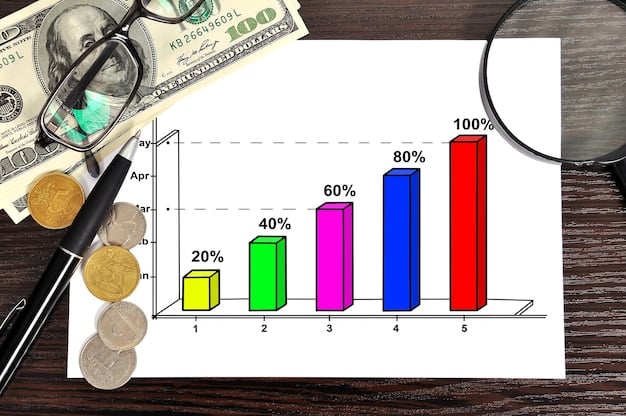Tax-Smart Investing: A Guide to Minimizing Capital Gains in 2025

Navigating the complexities of capital gains taxes can significantly impact your investment returns; this guide provides actionable strategies for tax-smart investing in 2025, helping you minimize your tax liabilities and maximize your financial growth.
Understanding and implementing tax-smart investing: how to minimize capital gains taxes in 2025 is vital for maximizing your investment returns, ensuring that you keep more of what you earn.
Understanding Capital Gains Taxes
Capital gains taxes are levied on the profit you make from selling an asset, such as stocks, bonds, or real estate. Understanding how these taxes work is the first step in managing and minimizing them.
These taxes can significantly impact your overall investment returns, therefore, strategically managing your investments to mitigate these taxes is crucial.
Short-Term vs. Long-Term Capital Gains
The tax rate applied to your capital gains depends on how long you held the asset before selling it. Short-term capital gains, from assets held for one year or less, are taxed at your ordinary income tax rate. Long-term capital gains, from assets held for more than one year, are taxed at lower rates, which vary depending on your income level.
Current Capital Gains Tax Rates
As of 2024, long-term capital gains tax rates are 0%, 15%, or 20%, depending on your taxable income. However, these rates and income thresholds are subject to change, underscoring the importance of staying informed about potential tax law updates for 2025.
- Understanding current tax brackets helps you plan your investment strategies.
- Long-term investments generally attract lower tax rates.
- Staying updated on tax law changes is crucial for effective tax planning.
Understanding the basics of capital gains taxes, including the distinction between short-term and long-term gains, along with current tax rates, provides a foundation for tax-smart investing strategies in 2025.
Tax-Advantaged Accounts
Utilizing tax-advantaged accounts is one of the most effective ways to minimize capital gains taxes. These accounts offer various tax benefits that can significantly reduce your tax liability.
Tax-advantaged accounts allow your investments to grow without the burden of annual taxation, making them ideal for long-term financial goals.

401(k) and IRA
Traditional 401(k)s and IRAs allow you to contribute pre-tax dollars, reducing your taxable income in the year of contribution. Your investments grow tax-deferred, meaning you won’t pay taxes until you withdraw the money in retirement. While withdrawals are taxed as ordinary income, the tax-deferred growth can lead to significant savings over time.
Roth 401(k) and Roth IRA
Roth accounts, such as Roth 401(k)s and Roth IRAs, offer a different tax advantage. While contributions are made with after-tax dollars, your investments grow tax-free, and withdrawals in retirement are also tax-free, provided certain conditions are met. This can be particularly beneficial if you anticipate being in a higher tax bracket in retirement.
- Contribute to tax-deferred accounts to reduce taxable income now.
- Consider Roth accounts for tax-free growth and withdrawals in retirement.
- Diversify your retirement savings across different types of accounts.
Tax-advantaged accounts, such as 401(k)s and IRAs, are powerful tools for tax-smart investing, providing significant tax benefits and helping you build long-term wealth by deferring or eliminating capital gains taxes.
Tax-Loss Harvesting
Tax-loss harvesting is a strategy that involves selling investments at a loss to offset capital gains. This can help reduce your overall tax liability.
Understanding how to effectively implement tax-loss harvesting can provide substantial tax savings and improve your after-tax investment performance.
How Tax-Loss Harvesting Works
When you sell an investment at a loss, you can use that loss to offset any capital gains you’ve realized during the year. If your losses exceed your gains, you can deduct up to $3,000 of the excess loss from your ordinary income ($1,500 if married filing separately). Any remaining losses can be carried forward to future years.
The Wash-Sale Rule
It’s important to be aware of the wash-sale rule, which prevents you from repurchasing the same or substantially identical security within 30 days before or after the sale that created the loss. If you violate the wash-sale rule, you won’t be able to claim the loss for tax purposes.

- Sell losing investments to offset capital gains.
- Be mindful of the wash-sale rule to avoid disallowing the loss.
- Carry forward any remaining losses to future years.
Tax-loss harvesting is a strategic way to use investment losses to your advantage, reducing your tax liability and potentially improving your after-tax investment returns, but it requires careful attention to the wash-sale rule.
Asset Location Strategies
Asset location involves strategically placing different types of investments in different types of accounts to minimize taxes. This can be an effective way to optimize your tax situation.
By understanding the tax implications of different asset classes and account types, you can strategically allocate your investments to maximize after-tax returns.
Tax-Efficient vs. Tax-Inefficient Investments
Some investments are more tax-efficient than others. For example, investments that generate a lot of taxable income, such as high-yield bonds or actively managed mutual funds, are generally better held in tax-advantaged accounts. On the other hand, investments that generate primarily capital gains or qualified dividends, such as stocks or index funds, can be held in taxable accounts.
Strategic Allocation
The goal is to place tax-inefficient investments in tax-advantaged accounts, where the income they generate won’t be taxed until withdrawal (or possibly not at all, in the case of Roth accounts). This allows you to maximize the tax benefits of each account type.
- Hold tax-inefficient investments in tax-advantaged accounts.
- Keep tax-efficient investments in taxable accounts.
- Optimize your asset allocation across different account types.
Asset location strategies can help you optimize your tax situation by strategically allocating investments across different account types, maximizing the tax benefits and improving your after-tax returns.
Donating Appreciated Assets
Donating appreciated assets, such as stocks or real estate, to a qualified charity can be a tax-smart way to support a cause you care about while also reducing your tax liability.
Donating appreciated assets can provide a double benefit: supporting charitable causes and reducing your tax burden through deductions and avoiding capital gains taxes.
Tax Benefits of Charitable Donations
When you donate appreciated assets to a qualified charity, you can generally deduct the fair market value of the asset from your taxable income, up to certain limits. Additionally, you avoid paying capital gains taxes on the appreciation.
Qualified Charitable Distributions (QCDs)
If you are age 70 1/2 or older, you can make qualified charitable distributions (QCDs) from your IRA directly to a qualified charity. QCDs can satisfy your required minimum distributions (RMDs) and are excluded from your taxable income, providing a significant tax benefit.
- Donate appreciated assets to claim a deduction and avoid capital gains taxes.
- Consider qualified charitable distributions (QCDs) from your IRA if you’re over 70 1/2.
- Ensure the charity is qualified to receive tax-deductible donations.
Donating appreciated assets to a charitable organization is a strategy that allows you to support worthwhile causes while also gaining valuable tax benefits, making it a win-win situation for both you and the charity.
Staying Informed and Seeking Professional Advice
Tax laws and regulations are constantly changing, making it essential to stay informed and seek professional advice when needed. An experienced tax advisor can help you navigate the complexities of the tax code and develop a personalized tax-smart investment strategy.
Staying informed and seeking expert advice ensures that you’re making the most of tax-saving opportunities and remaining compliant with all applicable tax laws.
Following Tax Law Updates
Keep an eye on changes to tax laws and regulations that could affect your investment strategies. Subscribe to reputable financial news sources, follow tax experts on social media, and consult with a tax professional to stay up-to-date.
Working with a Tax Advisor
A qualified tax advisor can provide personalized guidance based on your individual circumstances. They can help you identify tax-saving opportunities, ensure compliance with tax laws, and develop a comprehensive tax-smart investment plan.
- Stay informed about changes to tax laws and regulations.
- Consult with a tax advisor for personalized guidance.
- Develop a comprehensive tax-smart investment plan.
Staying informed about tax law updates and seeking professional advice is crucial for managing your tax liability effectively and ensuring that your investment strategies align with your financial goals.
| Key Concept | Brief Description |
|---|---|
| 💰 Tax-Advantaged Accounts | Utilize 401(k)s and IRAs for tax benefits. |
| 📉 Tax-Loss Harvesting | Offset gains by selling losing investments. |
| 📍 Asset Location | Strategically place assets for tax efficiency. |
| charity Donating Assets | Donate appreciated assets to charities for tax benefits. |
Frequently Asked Questions (FAQ)
Capital gains taxes are taxes on the profit from selling an asset, such as stocks or real estate. The rate depends on how long you held the asset.
Accounts like 401(k)s and IRAs offer tax benefits, such as tax-deferred growth or tax-free withdrawals, reducing your overall tax liability.
Tax-loss harvesting involves selling investments at a loss to offset capital gains, reducing your tax liability. Watch out for the wash-sale rule.
Asset location involves placing tax-inefficient investments in tax-advantaged accounts and tax-efficient investments in taxable accounts.
Donating appreciated assets to qualified charities can allow you to deduct the fair market value and avoid paying capital gains taxes.
Conclusion
Minimizing capital gains taxes in 2025 requires a multifaceted approach, incorporating strategies like utilizing tax-advantaged accounts, tax-loss harvesting, strategic asset location, and charitable giving, along with staying informed and seeking expert advice to optimize your investment returns.





